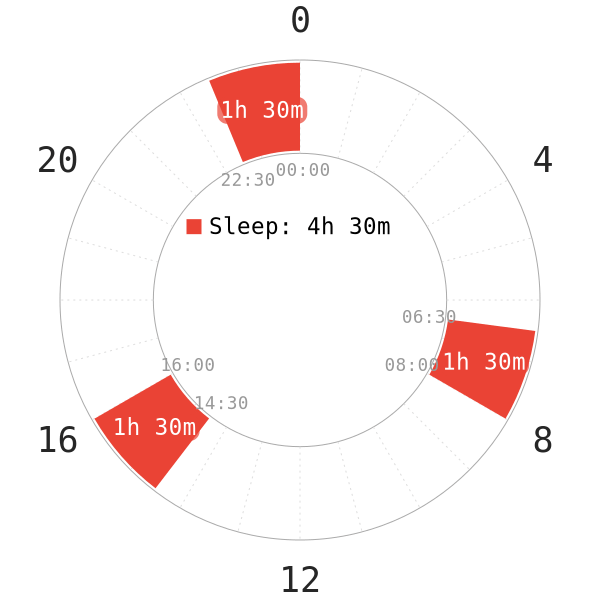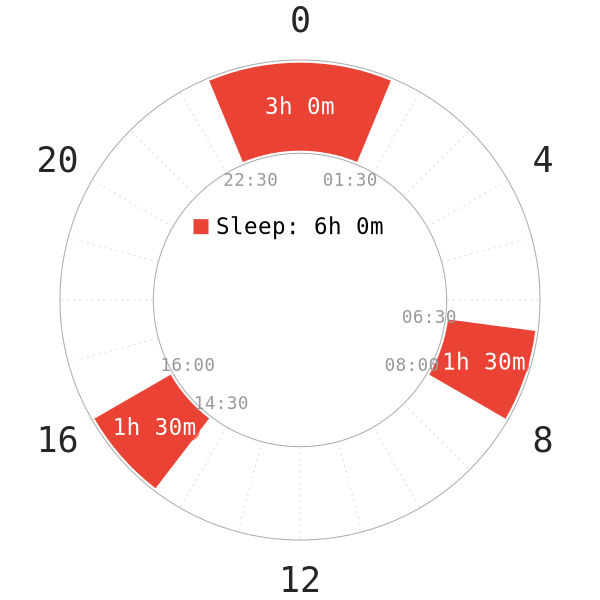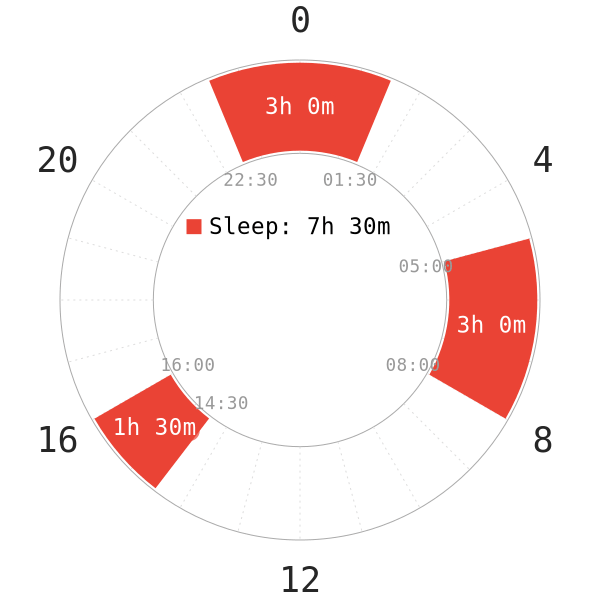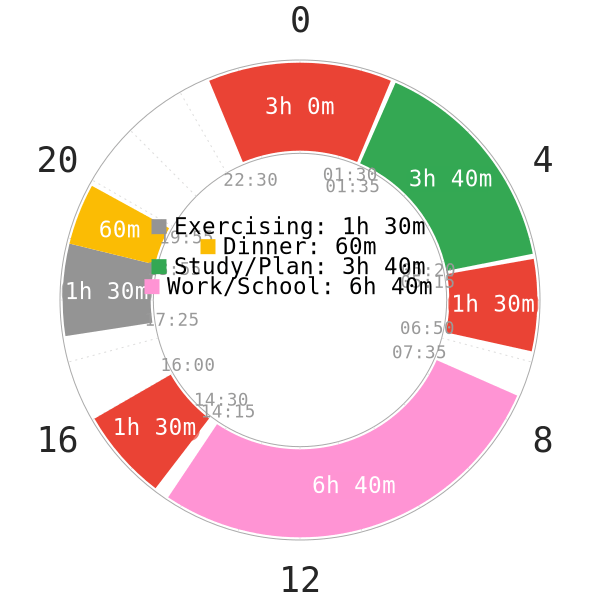
The original Triphasic schedule consists of 3 single-cycle equidistant sleep blocks; one sleep cycle every 8 hours. So in each 8-hour block, you stay awake for 6.5 hours and sleep for 1.5h. One could view this schedule as combination of segmented sleep with late siesta core. It is one of the 5 polyphasic schedules with only core sleeps.
Content
- Mechanism
- Adaptation
- Alternate Variants
- Lifestyle Considerations
Mechanism
Leif Weaver, the first successful Triphasic sleeper, remained on the schedule for several months.
- This schedule has equidistant sleep blocks, with a 6.5h wake period between each core sleep. Because of the structure, Triphasic is a more extreme Segmented-alike schedule. Despite the origin of the schedule, equidistant sleep is not a requirement. However, there should be no more than 8h wake gap between any core sleep.
- With the recorded successes in Triphasic, it is possible to stay awake for up to 9 hours from the daytime core to the core around SWS peak hours. This daytime wake period can be even longer on Triphasic-extended.
- The wake gap between the 2 other cores around night hours tends to be smaller.
- The core duration, 90m, matches with an average sleep cycle length.
- Because of the distribution of Triphasic sleep, it also possesses characteristics of Dual Core sleep. The evening core favors SWS, the sunrise core favors REM sleep and the daytime core contains mixed sleep stages.
Adaptation
Cold turkey
A possible adaptation route to Triphasic can be as follows:
- When adaptation first begins, SWS will resume in all core sleeps like a normal sleep cycle. Light sleep begins, then SWS enters and finally REM sleep finishes the cycle. In the second core, SWS pressure may be weaker than REM pressure, allowing for some REM sleep to get in this core.
- As adaptation progresses, both SWS and REM deprivation symptoms are likely to manifest because of the extreme repartitioning of these vital sleep stages.
- Each core sleep will demonstrate the homeostatic and circadian pressures respectively. This will make the first core very difficult to wake from, because of prevalent SWS wakes; a lot of attempters reported oversleeping until the second core.
- The daytime core is likely the easiest to handle, and can shorten to as low as 60m after adaptation.
Because of the high repartitioning of sleep stages on a mere 4.5h total sleep, Triphasic offers a lot of sleep reduction along with a high level of sleep compression. The cold turkey method, however, has accounted for most successful adaptations to Triphasic.
Gradual adaptation
One can first adapt to Segmented or Siesta sleep, and then transition to Triphasic. Segmented sleep fosters the split sleep mechanic, while Siesta has a 90m daytime core. However, the cold turkey method has reported more success over the years.
Alternate Variants
Aside from the non-equidistant Triphasic scheduling which has proven to be viable by a couple sleepers, the most popular and widely successful version is the extended version. A single cycle duration can range from 80m-120m in humans.
However, there are only successes with the default 90m cycle; it may be possible to schedule Triphasic with all core sleeps being ~100m or 120m to match personal cycle length.
Triphasic-extended

The extended version has multiple perks:
- The first core has more room for SWS; it also results in a higher chance to avoid many SWS wakes during adaptation.
- The total sleep time becomes 6h, which is usually a beginner-friendly sleep total. The adaptation then becomes a lot more manageable than on the regular version.
- The wake period from the REM core to the afternoon core can expand all the way to ~11h long (though you aren’t encouraged to attempt this!). However, most success has reported ~7-9h wake gap. This versatility greatly boosts the viability of Triphasic-extended or schedules with a daytime core.
- The first core can begin at late evening hours, around 11 or 11:30 PM without too much hassle, thanks to the increased total sleep.
- The total sleep also supports a physical lifestyle better.
- It is a lot easier to flex each sleep block after adaptation.
- The ability to schedule a much later daytime core aids in daily scheduling; the daytime core can move to ~4 or 5 PM.
- The core extension also suits individuals with somewhat high sleep requirements; an adaptation to the regular Triphasic would then become unsustainable.
With an overall easier adaptation than regular Triphasic, the night time hours between 2 nocturnal cores open up for various activities without having to sacrifice all productivity when adapting.
Alternatively, it may be possible to extend the REM core to 3h instead of the SWS core in the evening. This may be beneficial for social hours in the evening or less sleep in the early evening hours.
However, it has no known official successes to date; though, a sleeper with low SWS needs and high REM needs may still benefit from this Triphasic-extended variant.
Non-reducing Triphasic

Non-reducing Triphasic rarely sees much attempt; nevertheless, there have been some attempts recently, mostly from the underage population. It is unclear what the advantages would be with such a bulky and cumbersome sleep distribution, compared to Triphasic-extended. Success rate is also very rare, only a case or two.
The adaptation is potentially even easier than Triphasic-extended; however, this variant is only suitable for short-term goals or those who cannot sleep in one long chunk at night. The niches are very small; despite a lot of sleep, it may not be totally friendly to underage individuals, who are better with a non-reducing biphasic pattern instead.
Research
Wanna read some literature sources on Triphasic? Check them out here.
Lifestyle Considerations
Triphasic and Tri Core schedules overall are very unpopular because of the following reasons:
- The requirement to have a core in the SWS peak (especially on regular Triphasic) makes it necessary to forfeit social life around evening hours.
- The daytime core is limited to mostly siesta cultures (e.g, Spain) or if it is possible to sleep longer after work and before dinner.
- 4.5h total sleep is not sufficient to make it very flexible after adaptation. So far, there have only been 1 or 2 known adapted cases of being able to make a Triphasic core flexible; the flexibility is no more than 30m, though. With the limited flexibility for an average sleeper (with normal sleep needs), it is very challenging to sustain Triphasic long-term, even if the adaptation phase can be complete.
- Intense exercising may not be totally supported by Triphasic; increasing SWS requirements for recovery can prove to be very difficult to avoid SWS wakes in any cores.

Other utilities
In addition, Triphasic-extended has a whole lot more utility. It is one of the most well-rounded schedules and has reported a lot of success. With a versatile 6h sleep each day, sleepers gain quite a bit more extra time for their favorite activities. On another note, individuals with low sleep requirements can also learn to flex the cores on Triphasic to transition to CAMAYL.
Triphasic is overall a very unique polyphasic schedule in its own right. It can create a sense of very long days with a long wake gap between each core. Vivid dreaming is also common from the morning and daytime cores.
The short sleep blocks also resemble a nap-only schedule with only 3 sleeps per day. The exposure to a polyphasic system of only core sleeps will promise an eerie adaptation experience.
Main author: GeneralNguyen
Page last updated: 3 April 2021
